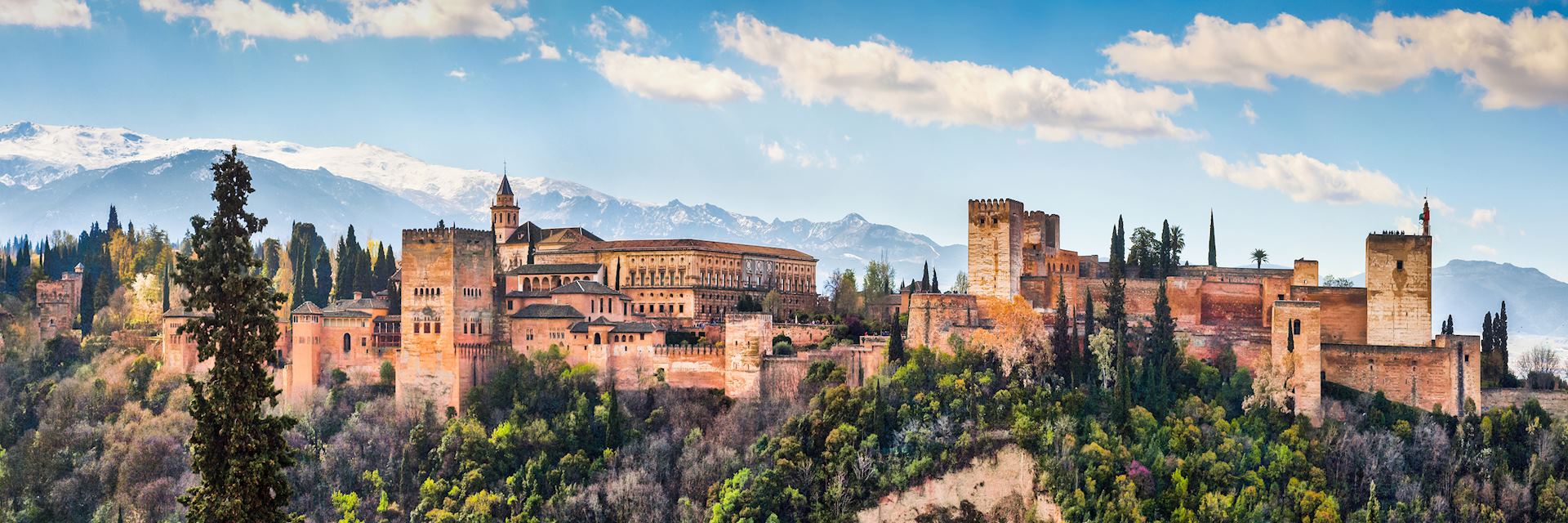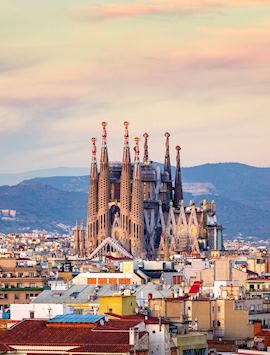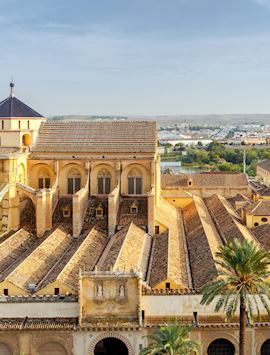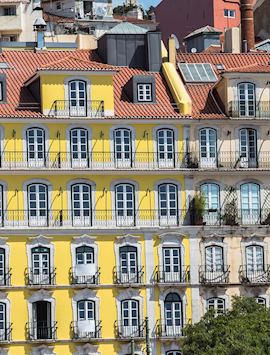By Europe Manager Tom
The twisty streets of old cities in Andalusia often resemble those in Morocco — narrow lanes to maximise shade, whitewashed buildings to reflect heat and houses built around hidden courtyards. A Muslim prince was the first to import orange trees to the region and you’ll see their descendants lining courtyards.
The Moors ruled Spain for seven centuries and they left their marks across the country, but especially in Andalusia. Even in a modern town like Marbella, if you slip past the beach-facing high rises, you’ll find medina-like streets and cobbled alleyways. But, the best places to see the remnants of the era are the three Moorish capitals: Seville, Córdoba and Granada.
What to see in Andalusia
Granada
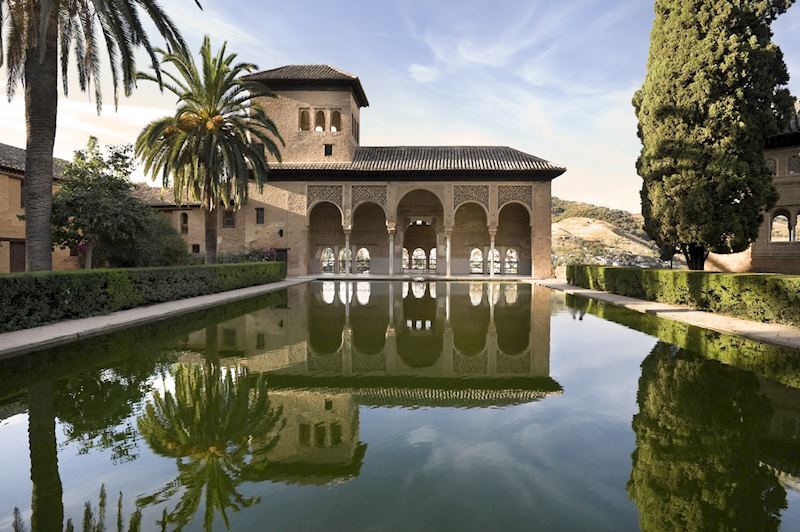
The last city taken by the Reconquista, Granada was the capital of the declining Moorish empire until it fell, at last, in 1492.
Of all Spain’s cities, Granada feels the most Moroccan to me — the old part of town, the Albaicín, reminds me of the medina in Fez. I like to get lost in the steep, crooked alleys, some barely wider than my shoulders. Houses present plain, whitewashed faces, but you can catch hints of the vibrant life within — the sound of water in a fountain or citrus trees overhanging the streets with glossy green leaves and bright fruit.
No matter how lost I get, if I just keep going uphill, eventually I arrive at Mirador de San Nicolás. This hilltop pedestrian plaza offers the best view across the valley to the Alhambra and the snow-kissed Sierra Nevada mountains. I’d come here in the evening, when there’s often a busker offering a flamenco-guitar soundtrack to accompany what Bill Clinton once called, ‘the most beautiful sunset in the world’.
It’s a good first glimpse of the Alhambra, a palace complex that dominates the city. As you’ll see in the buildings of the Albaicín, the exterior is very plain, only hinting at the extraordinary interior. Those forbidding terracotta walls, which earn the Alhambra its nickname Red Castle, remind you that it began as a fortress in the 9th century. It wasn’t until the 13th century that the Nasrid princes turned it into an opulent palace complex.
What can I say about the Nasrid Palace that hasn’t been said before? The calligraphy and scrolling patterns worked into the scalloped arches are so delicate they mimic finely wrought lace. ‘Only Allah is victorious,’ is repeated thousands of times, rendered in elegant script on the walls. Pay special attention to the ceilings and their repeating eight-pointed star motifs.
As in the Alcázar in Seville, water plays a vital role in the Alhambra. In the Patio de los Leones (Courtyard of the Lions), you’ll see a rare example of Islamic representative art — 12 lions supporting a large fountain, each jetting water from its mouth into a central runnel through the courtyard.
Even more than in the palaces, water is an integral part of the Generalife gardens. Horticultural masterpieces, the gardens’ name derives from the Arabic ‘jannat al-arifa’, loosely translated as ‘gardens of paradise’. Fountains, jets, channels and pools abound, a constant source of musical burbling and cooling breezes among the tumult of greenery, vines and blossoms.
If merely walking through the Alhambra seems like an inadequate way to appreciate its majesty, the Parador de Granada gives you the rare chance to spend the night. It’s located in the one-time Convento de San Francisco, the resting place for King Ferdinand and Queen Isabella before their tombs were constructed.
The rooms retain a sense of monastic restraint, with terracotta tile floors, whitewashed walls and wooden window shutters. You wake to the sound of running water in the courtyard, where you can sip a cup of coffee under the orange trees.
The Alhambra was surrendered to Castilian forces in early January 1492, the end of Muslim rule on the peninsula. Capturing Granada was a joint effort by Isabella and Ferdinand, who chose to be buried there as a symbol of their united kingdoms. You can see their tombs in a chapel behind the city’s cathedral. In the main cathedral, a Renaissance façade hides a soaring white-and-gold interior that’s decorated with Isabella’s private art collection, including works by Botticelli.
Córdoba
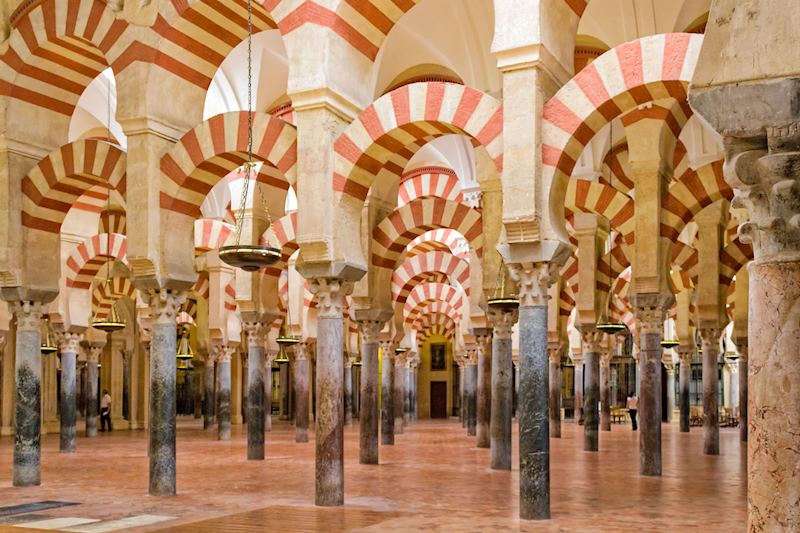
The Moorish Empire was at its height in the 10th century, and Córdoba was its capital. With almost a million residents, it was the largest city in Europe and its opulence rivalled Constantinople or Baghdad.
A major seat of learning, it housed one of the greatest libraries of the medieval world as well as some of the greatest scholars. Mosques, synagogues and churches all stood cheek by jowl and the architectural achievement of the era was the Mezquita mosque.
The Mezquita’s hypostyle prayer hall is always described as a ‘forest of pillars’, but nothing prepared me for the first time I entered the hushed, dim interior. The columns — many recycled from Roman ruins — seem to recede into infinity along multiple axes, making the vast space feel even larger. They’re joined by arches of white stone and red brick, evoking the striped tents of desert nomads or, perhaps, the curved fronds of date palms.
The focal point is the horseshoe-shaped mihrab, the prayer niche on the wall that faces Mecca. Its gold- and paint-backed glass tiles (tesserae) form a glittering mosaic in shades of dark blue, cinnamon brown, dull yellows and bright gold.
Smack in the midst of all this Islamic glory — awkward as a chicken in a swan’s nest — rises a Renaissance cathedral. A hodgepodge of European styles, it was begun in the 16th century by order of Carlos I and makes for a jarring contrast. However, the cathedral has its own appeal. I was particularly impressed by the massive double organ, which has more than 3,000 pipes, and the pink-and-red marble altarpiece.
To the north and west of the Mezquita, you’ll find the Judería. Once the Jewish quarter, it was home to some of the pre-eminent philosophers of the era, including the Talmudic scholar Maimónides and the Arab mathematician Averroès. Today, the Judería is a maze of narrow, shady streets, tree-line plazas and whitewashed buildings that sport black-iron window boxes overflowing with bright blooms.
You can visit a 14th-century synagogue that survived the Inquisition, a rare remnant of Spain’s once-thriving Jewish community. The elaborate Mudéjar stuccowork gracefully incorporates Hebrew calligraphy instead of Arabic. It’s a small temple, likely intended for private use, and you can still see the balcony where the women of the family worshipped.
When I visited Córdoba in May, it coincided with the Festival of the Courtyards, when the city flings open its gates and lets visitors peep into its private patios. Many of the best examples are in the Judería, but Cordobans across the city bedeck their courtyards in a riot of flowers. Those without patios take special care with their window boxes during the festival.
Seville
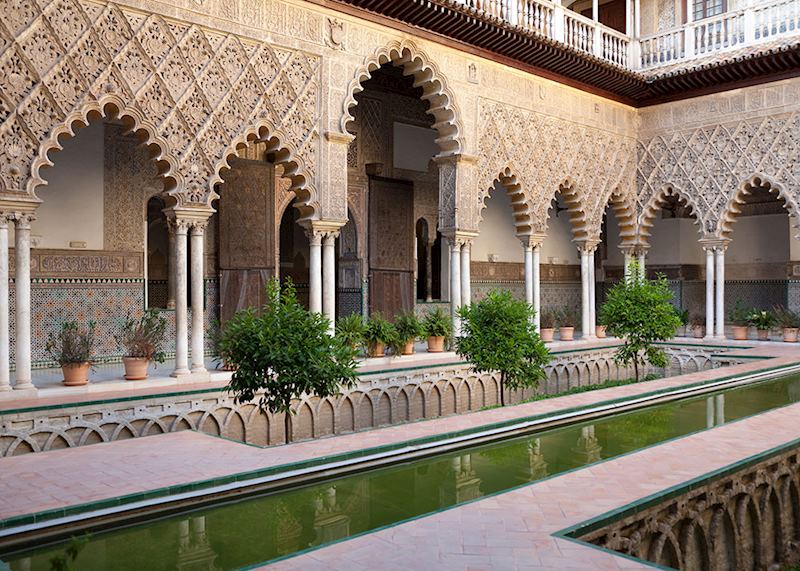
Moorish caliphs and Christian kings made Seville their capital at various times, and it remains one of the largest cities in Spain. A royal palace to this day, Seville’s Real Alcázar began life as a 10th-century fortress, though it has been rebuilt and enlarged countless times since.
The greatest expansion was in the 14th century, during the rule of Pedro I. He commissioned the Palacio Mudéjar, widely regarded as one of the finest examples of Mudéjar architecture in the world. The same Muslim artisans who worked on the Alhambra probably helped create this virtuosic complex for their new Christian king. I was amazed at their prowess in turning stone and plaster into such intricate filigree.
Moorish garden design reflects a deep reverence for water. In the Alcázar’s gardens, fountains, streams and reflecting pools interlace with the flower beds and meandering paths, overlooked by tall palm trees that cast pools of shade. The gardens were chosen as the stand-in for the Water Gardens of Dorne in Game of Thrones.
Across the way from the Alcázar, the heavily embellished Seville Cathedral offers a contrast to the palace’s severe exterior. The world’s largest Gothic building, dating from the late 1400s, it was raised on the site of a mosque with the purpose of re-establishing Christian dominance in the city. The towering gold altarpiece is interspersed with 1,000 brightly painted wooden figures that depict Biblical stories in sharp contrast to the abstract Islamic style.
Here, you’ll also find monuments to Spanish culture, including artwork by Goya, Murillo and Zurbarán, as well as the (likely) final resting place of Christopher Columbus.
A large hint to the city’s Moorish past still stands adjacent to the hulking cathedral — the Giralda, the bell tower, was converted from a minaret on the old mosque. Inside, you can walk to the observation deck up a ramp that allowed the muezzin to ride a mule to the top to sound the call to prayers. It’s a shallow but long climb through a dark space, lit only by the daylight that pierces the narrow slit windows. By the end, you appreciate the engineers’ consideration for the muezzin’s knees.
At the top, like the bell ringers and muezzins before you, you can appreciate a view of the city’s orange tiled roofs.
Best time to visit Andalusia
Andalusia is a year-round destination, though it can get exceptionally hot and dry in July and August. The weather is cooler and while it is the driest part of Spain there is some chance of rain from December to March. I think the best time to go is in May, when you can enjoy the Festival of the Courtyards and the gardens in bloom, but September and October also bring more comfortable weather, clear skies and fewer crowds.
Andalusia’s Moorish history

In 711 AD, North African Muslims invaded Andalusia, ushering in seven centuries of Muslim rule on the Iberian Peninsula. We say ‘the Moors’, but that’s an imprecise term that lumps together disparate factions from North Africa, including the Umayyads, Almohads and Nasrids.
These rulers brought with them a sophisticated culture that prized tolerance and scientific learning, something of a contrast to the rest of Europe during the Middle Ages. Scholars and engineers flourished across the peninsula, especially in Al-Andalus, as the southern region was known. Here, Muslims, Christians and Jews all lived and worked side by side.
Almost immediately after the Moorish armies invaded, Christian forces tried to drive them out — a long, uneven process called the Reconquista. It finally ended in 1492 when Granada fell to Queen Isabella I of Castile and King Ferdinand II of Aragon, who joined their two kingdoms to create modern Spain.
Many Muslims remained behind after the Reconquista swept through the region. The Mudéjar — literally ‘the left behind’ — included artisans who wielded their skills under Christian rule. You can still see Christian and Jewish buildings boasting Islamic-style decorations.
Read more about trips to Spain
Start thinking about your experience. These itineraries are simply suggestions for how you could enjoy some of the same experiences as our specialists. They’re just for inspiration, because your trip will be created around your particular tastes.
View All Tours in Spain
